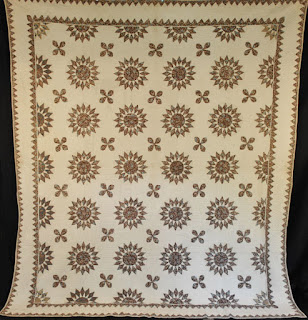Online auction
Found in Richmond, Virginia
When you come across a quilt like this and want to estimate a date there are a few excellent clues,
the most obvious being the fabrics. The white-ground chintz tells you the quilt is probably before 1850 (maybe before 1830).
The fringed border is another clue to "before the Civil War in 1860." Both design characteristics fell out of favor about 1850 so are useful in establishing a late date.
The pieced pattern is also a clue, but tells you more about the earliest possible date, rather than the latest. Could the quilt above be 1820s? How early were Americans piecing repeat-block, wheel-shaped patchwork?
Early, as evidenced by this quilt date-inscribed 1818 signed Mary Jones Orgaine.
See more about this quilt in the collection of the Briscoe Center here:
Another online example, this one from Susan W. Greene's collection.
She estimated the date as about 1820 with
both fabric and pieced design contributing to that conclusion.
Quilt date-inscribed 1833 S.S. Larkin.
Old Sturbridge Village
Mary Esther Smith,
Connecticut project & the Quilt Index
Collection of the National Museum of American History,
Smithsonian, Gift of Patricia Smith Melton.
The pattern was apparently quite popular (think
of all the 1810-1850 examples that have disappeared!)
It is interesting that all the blocks above have 16 spokes.
#3480 in Block Base.
(The proportion of the diamond shape is a little long here but I'd still call it #3480)
The pattern has been published many times under different names. We might call it a Sunflower but that's probably not the early-19th-century name.
The number of spokes is not always 16. Here's one
dated 1832 with 14 spokes.
Again, 14 divisions (not the geometry I'd be choosing) from
the collection of the Los Angeles County Museum of Art.
From Stella Rubin's gallery of sold quilts: 18 diamonds
and not a square block.
I've been posting photos of early date-inscribed quilts to Pinterest so
I can get an overview of patterns decade by decade. I noticed the
development of circular pieced repeat designs in the teens.
Have none in the 1820s but seven circular designs of various construction in the 1830s.
Notice the red arrows.
Making me think that rather complicated circular patterns
were among the earliest in establishing an American patchwork style.
Block from about 1950
The pattern tells you nothing about the latest possible date. Quilters continue to use it. If you are inclined to try a geometric challenge these early examples may give you some design ideas.
And one last early beauty: 20 points and lots of chintz
from the collection of the Marquette Regional History Center in Michigan.
Photo from the Quilt Index




















What a coincidence you should be talking about this pattern. And thank you by the way, for I noticed this on Audrey's blog, Quilty Folk, recently. Was wondering what the pattern was called and thought about trying it. Now I know, and perhaps when I finish 147 other projects, I can play with a new one, Sunflower!
ReplyDeleteThe fabric on the last quilt really looks like Bannister Hall; it must be a good reproduction for the quilt to be dated 1876-1900. Debby C
ReplyDelete